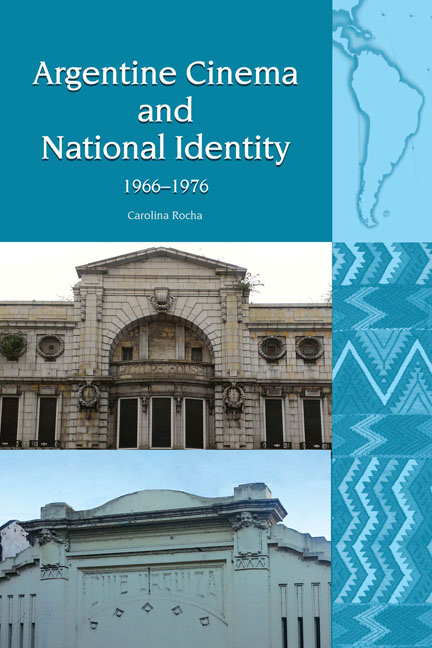Book contents
- Frontmatter
- In Memory of Paulina Piselli (1937–2017)
- Contents
- Acknowledgements
- Introduction
- Section I Argentine History and National Cinema, 1955–1976
- 1 Political and Social Tensions in Post-1955 Argentina
- 2 Argentine Cinema in the Late 1950s and Early 1960s
- 3 Argentine Cinema, 1966–1973
- 4 Argentine Cinema, 1973–1976
- Section II The Cinematic Gauchesque
- Section III Representing Founding Fathers
- Conclusion
- Bibliography
- Index
3 - Argentine Cinema, 1966–1973
from Section I - Argentine History and National Cinema, 1955–1976
- Frontmatter
- In Memory of Paulina Piselli (1937–2017)
- Contents
- Acknowledgements
- Introduction
- Section I Argentine History and National Cinema, 1955–1976
- 1 Political and Social Tensions in Post-1955 Argentina
- 2 Argentine Cinema in the Late 1950s and Early 1960s
- 3 Argentine Cinema, 1966–1973
- 4 Argentine Cinema, 1973–1976
- Section II The Cinematic Gauchesque
- Section III Representing Founding Fathers
- Conclusion
- Bibliography
- Index
Summary
To solve the glitches of Law 62/57, another cinema law was passed in 1966. One of the problems of this law was that the percentage received by producers as loans/subsidies could well exceed a film's box office takings and total costs. For instance, Del brazo y por la calle [Arm in Arm Down the Street] received 8,582,794 million pesos from the NIC while, as shown in Table 2, its box office takings were less than 5 million. Similarly, Castigo al traidor [Punishment to the Traitor] had a pending balance with the NIC of 6,007,956 million pesos, but received only 981,176, still significantly more than its box office takings of 769,390 pesos (‘Optimismo,’ 1966, 381). This state of affairs had led Grassi to warn in February 1966 that the refunds from the NIC would be one of the main areas of change in the cinema law (‘Recuperación,’ 1966, 47). Consequently, it was promised that the eight films/producers that still needed to be paid would see their refunds in January 1967, provided that the NIC's takings were strong (‘El resto,’ 1966, 389). High subsidies had depleted the NIC's operational funds even though its revenue had consistenly increased: according to Grassi, its income in 1963 was 300 million, 330 million in 1964, 440 million in 1965, and around 550–80 million in 1966 (‘Grassi se confiesa,’ 1966, 309).
Law 16,955—which amended that of 1957—was passed in September 1966, but without crucial input from those working in the Argentine film industry. Fundamentally, the new law sought to address the financial problems that were besieging the NIC, particularly the fondo de recuperación industrial [industrial recuperation fund]. The new law encouraged box office successes as film revenues could be used to finance up to 75% of future film productions, the reinvestment of earnings serving as an effective way to promote national films (‘Nueva ley de,’ 1966, 21). Nonetheless, the reinvestment of earnings was limited to what had been invested in film production, addressing the problem that some films received more funds than was spent on their production because of their solid performance at the box office. This new law also contemplated the end of the live performances that had generated so much controversy.
- Type
- Chapter
- Information
- Argentine Cinema and National Identity (1966–1976) , pp. 41 - 60Publisher: Liverpool University PressPrint publication year: 2018

